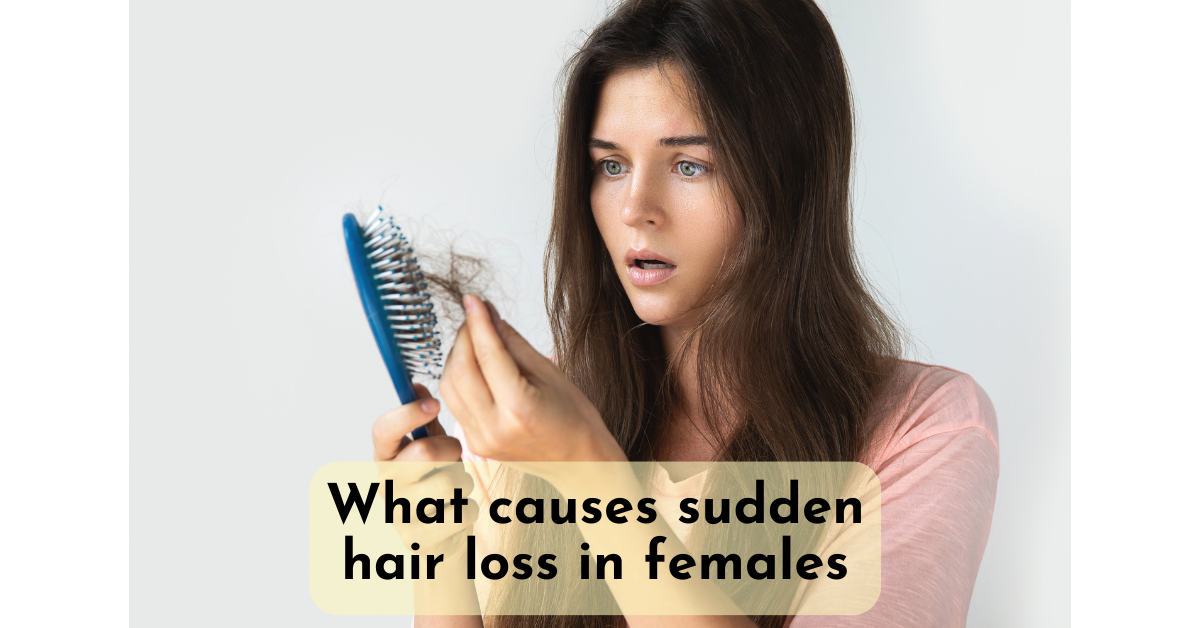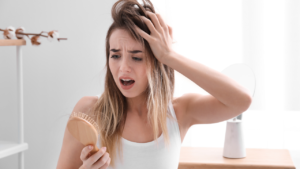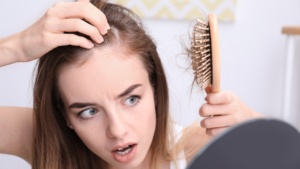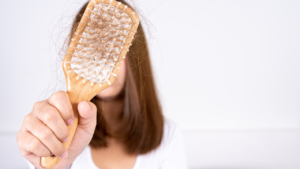Hair loss can be a distressing experience, especially for females. Whether it’s finding more hair on your brush or noticing thinning patches on your scalp, sudden hair loss can affect your confidence and self-esteem. But what causes this phenomenon? Let’s explore the common causes of sudden hair loss in females and gain a better understanding of this condition.
Key Takeaways:
- Female hair loss can occur at any age and for various reasons.
- Interference with the hair growth cycle can lead to sudden hair loss.
- Common causes include medications, illnesses, infections, age, hormones, and stress.
- Understanding the hair growth cycle is essential in comprehending the process of hair loss.
- Female pattern baldness is the most common cause of hair loss in females.
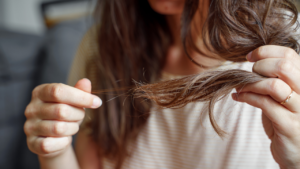
The Hair Growth Cycle Explained
The hair growth cycle consists of three phases: anagen, catagen, and telogen. Understanding these phases is crucial in comprehending the dynamics of hair growth and the factors that can contribute to hair loss.
Anagen Phase
The anagen phase is the active growth phase of the hair cycle. During this phase, new cells are formed at the root of the hair follicles, and hair grows at a rate of about half an inch per month. The duration of the anagen phase can vary from 2 to 8 years, depending on genetics and other factors. It is the longest phase of the hair growth cycle.
Catagen Phase
The catagen phase is a transitional phase that follows the anagen phase. It lasts for about two weeks and is characterized by the cessation of hair growth. During this phase, the hair follicle shrinks in size, and the hair shaft separates from its blood supply. The catagen phase signals the end of active growth and the onset of hair regression.
Telogen Phase
The telogen phase is the resting phase of the hair growth cycle. It lasts for about 2 to 4 months and is the final phase before hair shedding. During this phase, the hair follicle remains dormant, and the old hair is pushed out by the new hair that is growing in the anagen phase. On average, about 10-15% of hairs are in the telogen phase at any given time.
“Understanding the hair growth cycle and the different phases it consists of can help us grasp the complexity of hair growth and the potential factors that can disrupt this process.”
It is important to note that each hair follicle operates independently, meaning that hair strands are not all in the same phase at the same time. This natural variation is what allows for a continuous and healthy hair growth cycle. However, disruptions in the hair growth cycle can occur due to various factors, such as medications, illnesses, hormonal changes, and even styling habits, leading to hair loss.
Common Symptoms of Hair Loss in Females
Females experiencing hair loss may notice several common symptoms that can indicate the presence of this condition. These symptoms include:
- Hair thinning: The hair may appear less dense and thinner than usual, especially on the top third to half of the scalp.
- Visible scalp: Patches of the scalp may become more noticeable, particularly when the hair is pulled back or styled in certain ways.
- Increased hair shedding: Finding more hair than usual in combs or on pillows, towels, or clothes is a common sign of hair loss in females.
As the condition progresses, the widening of the part and decreased fullness of a ponytail can also be observed. It is important to note that these symptoms can vary in severity and may be different for each individual.
It is recommended to consult with a healthcare professional or a dermatologist if you experience any of these symptoms to determine the underlying cause of hair loss and explore appropriate treatment options.
Keep in mind that self-diagnosis is not recommended, as hair loss can have various causes and requires proper evaluation by a medical expert.
Female Pattern Baldness: The Most Common Cause of Hair Loss in Females
Female pattern baldness, also known as androgenetic alopecia, is the most common cause of hair loss in females. It is characterized by a gradual thinning of hair on the top third to half of the scalp. This condition has a strong genetic component and can be inherited from either the mother or father. Hormonal changes during menopause can also contribute to this type of hair loss. As women age, the hair follicles gradually shrink in size, leading to finer and thinner hair growth. Without treatment, symptoms may worsen over time.
Female pattern baldness typically starts with a widening part, increased scalp visibility when hair is pulled back, and a less full ponytail. Over time, the hair loss may progress to thinning on the top of the scalp, leaving the hairline intact. It is important to note that female pattern baldness differs from male pattern baldness, which often results in a receding hairline and bald patches on the crown of the head.
While female pattern baldness can be distressing, there are treatment options available to help slow down or prevent further hair loss. These may include topical minoxidil, which is applied directly to the scalp, low-light lasers, prescription oral medications (used off-label), platelet-rich plasma, and microneedling. It is recommended to consult with a healthcare professional or dermatologist to determine the best course of treatment based on individual circumstances and needs.
Possible Causes of Female Pattern Baldness:
- Genetic component inherited from either the mother or father
- Hormonal changes during menopause
It is important to note that female pattern baldness is a common condition and does not pose any health risks. However, it can have a significant impact on a woman’s self-esteem and confidence. Seeking support from healthcare professionals or support groups can be beneficial in managing the emotional aspects of hair loss and exploring available treatment options.
| Treatment Options for Female Pattern Baldness | Description |
|---|---|
| Topical minoxidil | Applied directly to the scalp to promote hair growth |
| Low-light lasers | Used to stimulate hair follicles and encourage regrowth |
| Prescription oral medications (used off-label) | May help slow down or prevent further hair loss |
| Platelet-rich plasma | Uses the patient’s own blood plasma to stimulate hair growth |
| Microneedling | Involves creating small punctures in the scalp to promote hair regrowth |
Other Types of Hair Loss in Females
Aside from female pattern baldness, there are several other types of hair loss that can affect females. These include anagen effluvium and telogen effluvium.
Anagen Effluvium
Anagen effluvium is a type of hair loss that occurs as a result of medications or treatments that harm the hair follicles. This can include chemotherapy drugs, which are known to cause hair loss as a side effect. The hair loss typically occurs rapidly and affects the entire scalp. However, once the medication or treatment is stopped, the hair can usually regrow.
Telogen Effluvium
Telogen effluvium is a condition in which a large number of hair follicles prematurely enter the resting phase of the hair growth cycle. This can be triggered by a variety of factors, such as illness, stress, hormonal changes, nutritional deficiencies, and medications. Telogen effluvium often leads to diffuse hair thinning rather than complete baldness. However, with proper treatment and addressing the underlying cause, the hair can usually grow back.
Other Causes of Hair Loss
In addition to anagen effluvium and telogen effluvium, there are many other conditions and factors that can contribute to hair loss in females. These include pregnancy, thyroid disorders, anemia, ringworm, scalp infections, autoimmune diseases, scarring alopecia, hormonal imbalances, certain medications, physical or emotional stress, and trichotillomania. It is important to identify the specific cause of hair loss in order to determine the most appropriate treatment options.
| Hair Loss Cause | Description |
|---|---|
| Anagen Effluvium | Hair loss caused by medications or treatments that harm the hair follicles, such as chemotherapy. |
| Telogen Effluvium | Hair loss triggered by a large number of hair follicles entering the resting phase prematurely. |
| Pregnancy | Hormonal changes during pregnancy can lead to temporary hair loss. |
| Thyroid Disorders | Conditions such as hypothyroidism or hyperthyroidism can affect hair growth. |
| Anemia | Low iron levels can contribute to hair loss. |
| Ringworm | A fungal infection of the scalp that can cause hair loss. |
Understanding the different types and causes of hair loss in females is crucial in order to determine the appropriate treatment options. If you are experiencing hair loss, it is recommended to consult with a healthcare professional who specializes in hair loss to receive an accurate diagnosis and customized treatment plan.
Hormonal Causes of Hair Loss in Females
Hair loss in females can be influenced by hormonal imbalances, with two common culprits being menopause and polycystic ovary syndrome (PCOS).
Menopause: The hormonal changes associated with menopause can trigger hair loss in females. As estrogen and progesterone levels decline, hair may become thinner, more prone to breakage, and grow at a slower rate. This can result in noticeable hair thinning and an overall reduction in hair volume.
Polycystic ovary syndrome (PCOS): Women with PCOS may experience hair loss due to an excess production of androgens, which are male hormones like testosterone. These hormonal imbalances can lead to hair thinning, particularly at the crown of the head.
Managing hormonal causes of hair loss in females often involves addressing the underlying hormonal imbalances. For menopausal hair loss, hormone replacement therapy or other medications may be recommended to rebalance hormone levels and promote hair growth. In the case of PCOS-related hair loss, treatment options may include medications to regulate hormone levels and lifestyle changes to improve overall hormonal balance.
Table: Hormonal Causes of Hair Loss in Females
| Cause | Symptoms |
|---|---|
| Menopause | Thinning hair, slower hair growth, reduced hair volume |
| Polycystic ovary syndrome (PCOS) | Hair thinning, particularly at the crown of the head |
Hair Loss Related to Styling Habits
Certain styling habits can contribute to hair loss in females. One common cause is traction alopecia, which occurs when hairstyles put excessive tension on the hair. Styles such as braids, pigtails, and cornrows can pull the hair tight, leading to hair breakage and thinning over time. It is important to avoid wearing these tight hairstyles consistently and to give the hair a break to prevent traction alopecia.
Another factor that can contribute to hair loss is heat damage from styling tools like blow dryers and flat irons. Exposing the hair to high heat can weaken the hair shaft, leading to breakage and thinning. To minimize heat damage, it is recommended to use heat protectant sprays and to set styling tools to lower temperatures. It is also beneficial to let the hair air dry whenever possible.
Harsh chemicals from bleaching, perming, or using other hair products can also contribute to hair loss. These chemicals can weaken the hair and make it more susceptible to breakage. It is important to choose hair products that are gentle and free from harsh chemicals. Regularly deep conditioning the hair can also help to strengthen and protect it from damage.
Over-shampooing or excessive brushing and combing, especially when the hair is wet, can also contribute to hair loss. Wet hair is more fragile and prone to breakage, so it is important to handle it gently. Instead of brushing, it is recommended to use a wide-toothed comb or detangling brush to remove knots and tangles. Additionally, it is advisable to avoid excessive shampooing, as it can strip the hair of its natural oils, leading to dryness and breakage.
Table: Common Styling Habits That Can Contribute to Hair Loss
| Styling Habit | Potential Impact on Hair Loss |
|---|---|
| Tight hairstyles (braids, pigtails, cornrows) | Traction alopecia, hair breakage and thinning |
| Heat styling (blow dryers, flat irons) | Heat damage, weakened hair shaft, breakage and thinning |
| Harsh chemicals (bleach, perms, other hair products) | Weakened hair, breakage and thinning |
| Over-shampooing, excessive brushing and combing | Hair breakage, dryness, and thinning |
By being mindful of styling habits and implementing hair-friendly practices, it is possible to reduce the risk of hair loss. Opting for looser hairstyles, minimizing heat exposure, choosing gentle products, and handling the hair with care can help maintain its health and prevent unnecessary breakage and thinning.
Hair Loss in Females Due to Medical Conditions
Hair loss in females can be caused by various medical conditions. Understanding these underlying conditions can help determine the appropriate treatment plan. Here are some medical conditions that can contribute to hair loss in females:
Pregnancy
During pregnancy, hormonal changes can affect hair growth cycles. While some women experience thicker, fuller hair during pregnancy, others may notice hair shedding or thinning after giving birth. This is usually temporary and resolves within a few months as hormone levels normalize.
Thyroid Disorders
Thyroid disorders, such as hypothyroidism (underactive thyroid) or hyperthyroidism (overactive thyroid), can disrupt the hair growth cycle. In hypothyroidism, hair may become brittle, dry, and thin, whereas in hyperthyroidism, hair loss may be more diffuse. Proper management and treatment of thyroid disorders can help improve hair health.
Anemia
Anemia is a condition characterized by low iron levels in the blood. Iron deficiency can affect the hair follicles’ ability to receive proper nutrients and oxygen, leading to hair loss. Treating the underlying cause of anemia and addressing iron deficiency through diet or iron supplements can help prevent further hair loss.
Other Medical Conditions
Other medical conditions that can cause hair loss in females include ringworm (a fungal infection of the scalp), scalp infections, sexually transmitted infections, high fever, autoimmune diseases like alopecia areata, scarring alopecia (hair loss due to scarring), and diabetes. Each condition may require specific treatments to address hair loss and manage the underlying condition.
| Medical Condition | Symptoms | Treatment |
|---|---|---|
| Pregnancy | Hair shedding or thinning after childbirth | Usually resolves on its own; healthy diet and supplements |
| Thyroid Disorders | Brittle, dry, or thinning hair in hypothyroidism; diffuse hair loss in hyperthyroidism | Thyroid medication; hormone management |
| Anemia | Hair loss due to low iron levels | Dietary changes; iron supplements |
| Other Medical Conditions | Vary depending on the specific condition | Treatment of underlying medical condition |
Remember, if you are experiencing hair loss, it is essential to consult with a healthcare professional to determine the underlying cause and develop a personalized treatment plan. Addressing medical conditions and managing any contributing factors can help promote healthy hair growth.
Medications and Hair Loss in Females
Medications can sometimes be the culprit behind hair loss in females. Certain drugs, such as birth control pills, blood thinners, and steroids, have the potential to cause hair loss as a side effect. It’s important to note that not all women who take these medications will experience hair loss, but for those who do, it can be a distressing and noticeable change.
Birth Control Pills: Some women may find that certain formulations of birth control pills can lead to hair shedding or thinning. This can happen particularly when switching to a new brand or type of pill. It’s important to discuss any concerns or changes in hair loss with your healthcare provider, who can help find an alternative method of contraception that may be more suitable.
Blood Thinners: Blood thinners such as warfarin or heparin are commonly prescribed to prevent blood clots. However, these medications can sometimes contribute to hair loss. If you’re experiencing hair thinning or shedding while taking blood thinners, it’s essential to consult your doctor for further evaluation and potential adjustment of your medication regimen.
Steroids: Corticosteroids, such as prednisone, are powerful anti-inflammatory drugs commonly used to treat a range of conditions. Unfortunately, one of the potential side effects of long-term steroid use is hair loss. If you’re concerned about the impact of steroids on your hair health, consult your healthcare provider to explore alternative treatment options or ways to minimize hair loss.
“When taking certain medications, hair loss can be an unexpected and unwelcome side effect. If you notice excessive hair shedding or thinning while on any medication, it’s crucial to reach out to your doctor for guidance. They can assess your individual situation and recommend potential adjustments or alternative treatments to help manage hair loss.”
Stress and Hair Loss in Females
Hair loss in females can be triggered by both physical and emotional stress. Intense physical stress from events such as surgery or childbirth can lead to hair loss a few weeks to months later. Emotional stress, such as grief, divorce, or unemployment, can also result in hair loss. This type of hair loss is usually temporary, and the hair often regrows within 6-9 months after the stressor is resolved.
Physical stress is a common cause of hair loss in females. Major surgeries, illnesses, or significant weight loss can disrupt the hair growth cycle, leading to increased shedding or thinning of the hair. The body prioritizes its resources during times of physical stress, redirecting nutrients away from non-essential functions like hair growth. As a result, the hair follicles enter a resting phase and eventually shed hair, causing a noticeable decrease in hair volume. Once the body recovers from the physical stress, the hair growth cycle typically returns to normal, resulting in regrowth of the lost hair.
Emotional stress can also contribute to hair loss in females. The body’s response to emotional stress causes an imbalance in hormone levels and can disrupt the normal hair growth cycle. This disruption can lead to excessive shedding or reduced hair growth. Emotional stress can trigger a condition called telogen effluvium, where a large number of hair follicles enter the resting phase simultaneously, resulting in noticeable hair loss. Managing and reducing emotional stress through self-care, therapy, and stress-reducing techniques can help improve hair health and promote regrowth.
The Effects of Stress on Hair Growth
Stress-related hair loss, whether caused by physical or emotional stress, can be distressing for females. The exact mechanisms behind stress-induced hair loss are not fully understood, but experts believe that stress can disrupt the normal functioning of hair follicles. Stress hormones, such as cortisol, can affect the hair growth cycle, leading to hair loss when produced in excess. Additionally, stress can cause inflammation and damage to the scalp, further impacting hair health.
| Physical Stressors | Emotional Stressors |
|---|---|
| Surgery | Grief |
| Illnesses | Divorce |
| Significant Weight Loss | Unemployment |
To mitigate the effects of stress on hair loss, it is important to manage stress levels and prioritize self-care. Engaging in stress-reducing activities such as exercise, meditation, and practicing relaxation techniques can help alleviate emotional and physical stress. Seeking support from loved ones, joining support groups, or consulting a therapist can also be beneficial in managing stress and its impact on hair health.
Hair Loss Due to Nutritional Deficiencies and Eating Disorders
Nutritional deficiencies can have a significant impact on hair health in females. Insufficient intake of essential nutrients can lead to weakened hair follicles, thinning hair, and even hair loss. Among the most common nutritional deficiencies that are associated with hair problems are vitamin deficiency, iron deficiency, and those caused by eating disorders.
Vitamin deficiency can affect the overall health of the hair. For example, a deficiency in vitamin A can lead to dryness and dullness, while a lack of vitamin D can contribute to hair thinning. Iron deficiency is another common cause of hair loss, as iron is vital for the production of red blood cells and the delivery of oxygen to hair follicles.
Eating disorders, such as anorexia or bulimia, can result in severe malnutrition and lead to hair loss. These disorders often involve restricted food intake and imbalances in essential nutrients, depriving the body and hair follicles of the necessary sustenance for healthy hair growth. Addressing these eating disorders and adopting a balanced, nutrient-rich diet is crucial for restoring optimal hair health.
Table: Common Nutritional Deficiencies and Their Effects on Hair
| Nutrient | Effect on Hair |
|---|---|
| Vitamin A | Dryness and dullness |
| Vitamin D | Thinning hair |
| Iron | Hair loss due to insufficient oxygen delivery |
In conclusion, nutritional deficiencies, especially those related to vitamins and minerals, can contribute to hair loss in females. Adequate intake of essential nutrients and the adoption of a balanced diet are crucial for maintaining healthy hair. In cases where eating disorders are the underlying cause, it is essential to seek professional help and support to address the root causes and restore optimal nutritional balance.
Conclusion
In conclusion, hair loss in females can be a distressing condition that can have a significant impact on self-esteem and overall well-being. Understanding the underlying causes of hair loss is crucial in order to develop an effective treatment plan. It is important to consult with a healthcare professional to determine the root cause of hair loss and explore appropriate treatment options.
There are various hair loss treatments available for females. Topical minoxidil, a medication that promotes hair growth, has shown promising results in treating female pattern baldness. Low-light lasers, prescription oral medications (used off-label), platelet-rich plasma, and microneedling are also among the treatment options that may be considered.
It is worth mentioning that the effectiveness of these treatments can vary depending on the individual and the underlying cause of hair loss. Therefore, it is crucial to seek professional advice and guidance to determine the most suitable treatment approach. With proper care and treatment, many females experiencing hair loss can regain confidence and achieve healthier hair growth.
FAQ
What are the common causes of sudden hair loss in females?
Common causes of sudden hair loss in females include medications, illnesses, infections, age, hormones, and stress.
What is the hair growth cycle?
The hair growth cycle consists of three phases: anagen (active growth), catagen (transition), and telogen (resting).
What are the symptoms of hair loss in females?
Symptoms of hair loss in females include finding more hair than usual in combs or on pillows, towels, or clothes, as well as in the shower drain. Hair may appear thinner, and patches of the scalp may become visible.
What is female pattern baldness?
Female pattern baldness, also known as androgenetic alopecia, is the most common cause of hair loss in females. It is characterized by a gradual thinning of hair on the top third to half of the scalp.
Are there other types of hair loss in females?
Yes, other types of hair loss in females include anagen effluvium (caused by medications) and telogen effluvium (caused by various factors). There are also other conditions and factors that can cause hair loss in females.
Can hormonal imbalances contribute to hair loss in females?
Yes, hormonal changes during menopause and conditions like polycystic ovary syndrome (PCOS) can contribute to hair loss in females.
Can styling habits cause hair loss in females?
Yes, hairstyles that pull the hair tight, high heat from styling tools, harsh chemicals, and over-shampooing or excessive brushing and combing can contribute to hair loss in females.
What medical conditions can cause hair loss in females?
Medical conditions such as pregnancy, thyroid disorders, anemia, scalp infections, autoimmune diseases, and diabetes can cause hair loss in females.
Can medications lead to hair loss in females?
Yes, medications such as birth control pills, blood thinners, and certain steroids are known to potentially cause hair loss in females.
Can stress contribute to hair loss in females?
Yes, both physical and emotional stress can lead to hair loss in females. Hair loss may occur a few weeks to months after a stressful event and is usually temporary.
Can nutritional deficiencies and eating disorders cause hair loss in females?
Yes, a shortage of certain nutrients and severe malnutrition can contribute to hair loss in females. A balanced diet and addressing any nutritional deficiencies are important for healthy hair growth.
What are the available treatments for hair loss in females?
Effective treatments for hair loss in females include topical minoxidil, low-light lasers, prescription oral medications (used off-label), platelet-rich plasma, and microneedling. It is important to consult with a doctor to determine the underlying cause of hair loss and develop an appropriate treatment plan.
You may also be interested in
Effective Solutions for Managing Hair Loss – Your Healthy Scalp Guide
Effective Hair Treatment for Women – Revitalize Your Locks Today!
Unlock the Secret to Healthy Skin with Our Hand Care Guide
Unlock Your Youth: Anti-aging for Women Strategies Revealed
How to Take Care of Your Lips Naturally: Essential Tips
Source Links
- https://www.webmd.com/skin-problems-and-treatments/hair-loss/women-hair-loss-causes
- https://www.mayoclinic.org/diseases-conditions/hair-loss/symptoms-causes/syc-20372926
- https://www.uclahealth.org/news/what-causes-female-hair-loss


